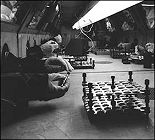To Native Americans, the home and workplace were much the same. “Going to work” meant moving out from shelter to the surrounding country – hunting and gathering to sustain a tenuous lifestyle.
Over many generations, immigrant newcomers to Minnesota coped with a constantly-evolving definition of the “homeplace” and the “work-place”. Pioneer farm families lived independent isolated lives, where home and work were largely one and the same. Except for that “periodic trip to town” for supplies, they relied on their own initiative, ingenuity and, as needed, local networking with neighbors.
With transportation limited, town and city dwellers of that time typically lived within walking distance of their work. As road and rail transportation improved, people more frequently chose to make their homes in the suburbs; and support businesses and industry followed. Post-WWII expansion of industrial electronics and cybernetics activity stimulated the growth of metropolitan Minnesota, and transformed the Twin Cities from two urban centers into a metropolitan region – a trend that continues to this day. |
|
|
Home and the Workplace

Farm family feeding chickens, ca. 1920 –
Low-tech chicken raising by pioneering farmers.
Minnesota Historical Society

Manufacturing and assembling
of transistors for radios at Honeywell,
Minneapolis, ca. 1960 – High-tech manufacturing.
Honeywell and Minnesota Historical Society
| Minnesota evolved through the early pioneering phase (when most residents were self-sufficient, independent farmers) into a society increasingly more urban and more industrially oriented, and characterized by a mass-consumer culture. Self-employed producers became employees of others. Technological change, guided by private business and controlled by experts, became the driving force. “All these changes meant that technology and products associated with technology took on a power and reality of their own. Correspondingly, ordinary people’s labor lost ground in visibility and importance.” Abundance was being defined in economic terms, inextricably tied to the purchase of consumer goods. Work was becoming a “means to an end”, not an “end in itself”. The concept of work as a “calling” – work that has a value in itself – has been sharply eroded. [BA] |
|





